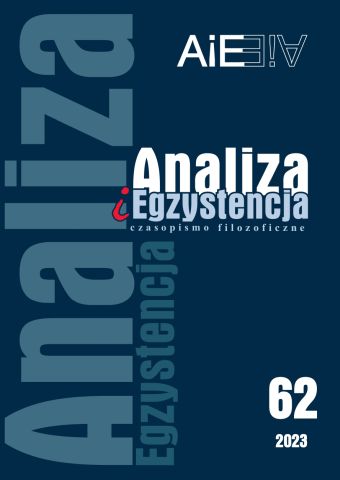
ISSN: 1734-9923
eISSN: 2300-7621
OAI
DOI: 10.18276/aie.2023.62-01





Issue archive /
62 (2023)
Real Deletion, Time, and Possibility
(Rzeczywiste usunięcie, czas i możliwość.)
| Authors: |
Randall
Auxier

Southern Illinois University, Carbondale |
| Keywords: | czas proces sztuczna inteligencja czasowość potencja Whitehead Bergson |
| Data publikacji całości: | 2023 |
| Page range: | 37 (5-41) |
Abstract
Abstract:
Does anything ever really “go away,” completely? This paper is a search for “real deletion,” and the metaphysics that must accompany real deletion. Why is that important? In artificial intelligence studies, researchers have offered a moving target for when artificial intelligence has been achieved. It began with the Turing test and has evolved through a thousand arguments (e.g., Dreyfuss’ What Computers Can’t Do, through Kurzweil’s “singularity” and into a hundred other criteria and thousands of discussions about what intelligence is and what it would mean to simulate or, as I favor, emulate it). This whole discussion is still just sorting through analogies to human intelligence, not approaching the thing itself, but good analogies must approach much more than analogous function: they must approach real indiscernibility. My arguments here will therefore be largely in the field of metaphysics and ontology, which is how I understand the word “real” in the phrase “real deletion.” I do not think that current researchers have rightly understood time and how it bears upon the criterion or. criteria of artificial intelligence. Hence, I offer “real deletion,” in the sense to be described, as the criterion. The AI argument has implications for all of metaphysics as it relates to the fundamental character of time.
Download file
Article file
Bibliography
| 1. | Anderson, M. (2019). Hyperthematics: The logic of value. SUNY Press. |
| 2. | Auxier, R. (1999). Influence as confluence: Bergson and Whitehead. Process Studies, 28(3–4), 301–338. https://doi.org/10.2307/44789317. |
| 3. | Auxier, R. (2013). Time, will, and purpose: Living ideas from the philosophy of Josiah Royce. Open Court. |
| 4. | Auxier, R. (2014a). Complex negation, necessity, and logical magic. In K. A. Parker, & J. M. Bell (Eds.), The relevance of Royce. Fordham University Press. |
| 5. | Auxier, R. (2014b). In vino veritas. Southwest Philosophy Review, 30(1), 39–66. https://doi.org/10.5840/swphilreview20143015 |
| 6. | Auxier, R. (2014c). Image and act: Bergson’s ontology and aesthetics. Sztuka i Filozofia, 45, 64–81. |
| 7. | Auxier, R. (2015). The sherpa and the sage: Neville on the determinate and the possible. American Journal of Theology & Philosophy, 36(1), 37–50. https://doi.org/10.5406/amerjtheophil.36.1.0037. |
| 8. | Auxier, R. (2016). Evolutionary time, and the creationof the space of life. In S. Wuppuluri, & G. Ghirardi (Eds.), Space, time, and the limits of human understanding (pp. 381–400). Springer Verlag. |
| 9. | Auxier, R., & Herstein, G. (2017). The quantum of explanation. Routledge. |
| 10. | Auxier, R. (2021). Logic: From images to digits. Rylan. |
| 11. | Auxier, R. (2022, June 21–24). The virtues in the virtual: Langer’s projections and the digital world [Conference presentation]. Feeling, Form, Mind: A Conference on the Thought of Susanne K. Langer, Max Planck Institute for Empirical Aesthetics, Frankfurt am Main, Germany. https://www.aesthetics.mpg.de/fileadmin/user_upload/300-Newsroom/EVENTS/220622-Conference-Susanne-K-Langer/Grueny-Susanne-Konferenz-Programm-Abstracts-07a-ONLINE.pdf. |
| 12. | Auxier, R. (2022, July 19–21) The virtues in the virtual: Langer’s projections and the digital world [Keynote speech]. International Conference on Robot Ethics and Standards, Korean Society for AI Ethics, the Korean Association for Ethics, and the CLAWAR Association, Seoul, South Korea. |
| 13. | Bergson, H. (1983). Creative evolution. University Press of America. |
| 14. | Bergson, H. (1988). Matter and memory. Zone Books. |
| 15. | Brightman, E. S. (1933). Moral laws. Abingdon Press. |
| 16. | Buchler, J. (1989). Metaphysics of natural complexes. SUNY Press. |
| 17. | Canales, J. (2015). The physicist and the philosopher. Harvard University Press. |
| 18. | Cassirer, E. (1923). Einstein’s theory of relativity (W. C. Swabey, & M.C. Swabey, Trans.). Open Court. |
| 19. | Eastman, T. E. (2020). Untying the Gordian knot: Process, reality, and context. Lexington Books. |
| 20. | Haynes, J. (2005). Comparative politics in a globalizing world. Polity. |
| 21. | Jones, J. A. (1999). Intensity: An essay in Whiteheadian ontology. Vanderbilt University Press. |
| 22. | Kant, I. (1987). Critique of judgment (W. S. Pluhar, Trans.). Hackett. |
| 23. | Kirkpatrick, A. T. (2020). Whitehead and Merleau-Ponty: Toward a process phenomenology [Master’s dissertation, Deakin University]. |
| 24. | Kokot, J. D. (2022). The phenomenology of temporality and the technologies of art [Doctoral dissertation, Boston University]. |
| 25. | Langer, S. (1967). An introduction to symbolic logic. Dover. |
| 26. | Mead, G. H. (1998). The present as the locus of reality. In D. Browning, & W. T. Myers (Eds.), Philosophers of process (pp. 349–370). Fordham University Press. |
| 27. | Merleau-Ponty, M. (1962). The phenomenology of perception. Routledge & Kegan Paul. |
| 28. | Murray, L. M. (2021). The crisis of dislocated beings [Prospectus Introduction]. Southern Illinois University. |
| 29. | Ohanian, H. (2009). Einstein’s mistakes. W. W. Norton and Co.Prigogine, I, & Stengers, I. (1984). Order out of chaos: Man’s new dialogue with nature. Bantam Books. |
| 30. | Sartre, J. P. (1948). The psychology of imagination. Philosophical Library. The Institute of Art and Ideas (2018). Why classical ideas of gravity are wrong: Chiara Marletto [Video]. YouTube. https://www.youtube.com/watch?v=dGe6N_FNB4g&t=2s. |
| 31. | Taleb, N. N. (2010). The black swan: The impact of the highly improbable. Random House. |
| 32. | Whitehead, A. N. (1922). The principle of relativity. Cambridge University Press. |
| 33. | Woit, P. (2007). Not even wrong. Basic Books. |
| 34. | Tengelyi, L. (2004). The wild region in life history. Northwestern University Press. |